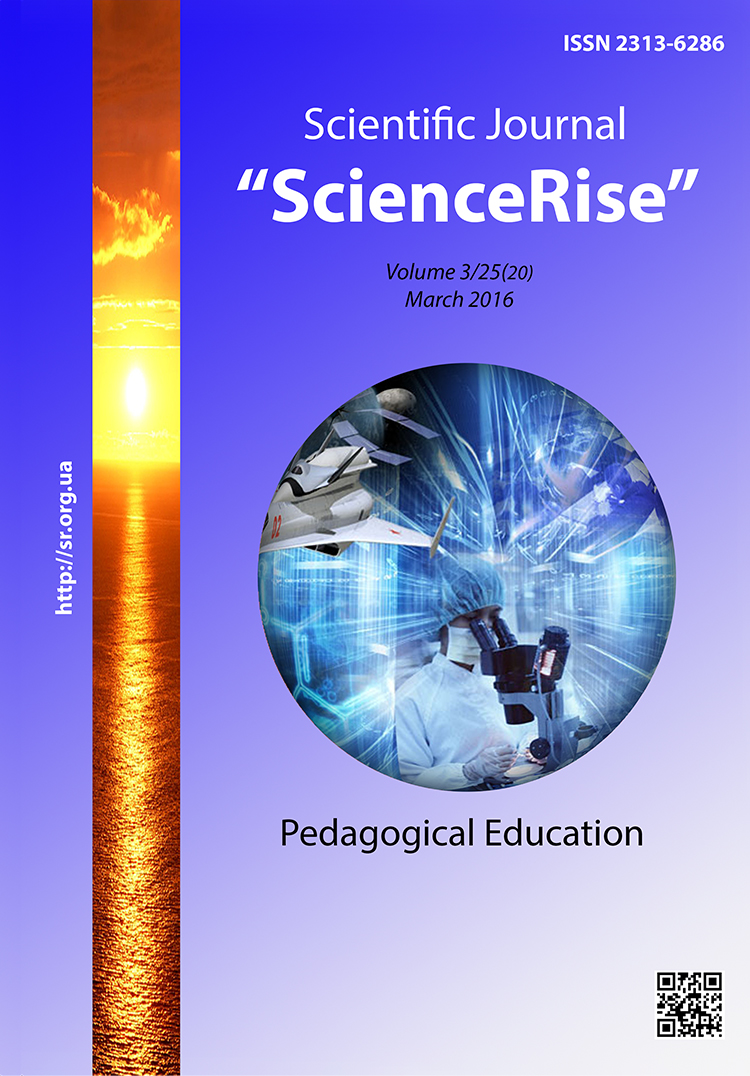Program and entrance results of verification of effectiveness of methodological system of engineering-graphics disciplines teaching of the future teachers of technologies
DOI:
https://doi.org/10.15587/2313-8416.2016.64141Keywords:
teacher of technologies, engineering-graphic preparation, methodological system, verification resultsAbstract
In the article was presented the program of scientific-pedagogical research of effectiveness of methodological system of engineering-graphic disciplines teaching of the future teachers of technologies. There was outlined the aim, tasks and main stages of research-experimental work, carried out the selection of the most rational methods of research.
An effective solution of the set tasks at the different stages of scientific search became possible owing to the complex use of theoretical, empirical and statistical methods of research.
The main method of scientific research was the pedagogical experiment directed on the special organization of educational process for approbation of elaborated methodological system of engineering-graphic disciplines teaching of the future teachers of technologies, verification of effectiveness of pedagogical conditions of its functioning and the complex of means for realization and pedagogical management.
The level of engineering-graphic preparation of the future teachers of technologies was determined in the process of the long psychological and pedagogical observations, questioning and interviewing of teachers and students and also by the results of pedagogical diagnostics which main methods was testing and carrying out the total control (graphic) works.
Analysis of the results of research received in the process of ascertaining stage of research-experimental work made possible the formulation of conclusions:
1. The educational process of engineering-graphic disciplines is unsystematic that is demonstrated in the absence of unitary approaches and claims to the quality of engineering-graphic preparation of students and in the use of different scientific-methodological means.
2. The level of engineering-graphic preparation of students does not correspond to the social order and needs of the modern comprehensive school for the qualified teachers of technologies able to carry out the training of pupils on the proper professional level and to support the development of individual abilities of each person.
3. In students was observed the mainly low level of engineering-graphic preparation.
4. It becomes necessary to introduce the scientifically grounded methodological system of engineering-graphic disciplines teaching of the future teachers of technologies oriented on the improvement of the level of engineering-graphic preparation of students in the conditions of the modern information society
References
Baskakov, A. Ya., Tulenkov, N. V. (2004). Metodologiya nauchnogo issledovaniya [Scientific Research Methodology]. Kyiv: MAUP, 216.
Zagvyazinskiy, V. I. (1982). Metodologiya i metodika didakticheskogo issledovaniya [Methodology and methods of didactic study]. Moscow: Pedagogika, 160.
Kyiveryalg, A. A. (1980). Metodyi issledovaniya v professionalnoy pedagogike [Research methods in vocational pedagogy]. Tallinn: Valgus, 334.
Novikov, A. M. (1996). Nauchno-eksperimentalnaya rabota v obrazovatelnom uchrezhdenii [Research and experimental work in an educational institution]. Moscow: RAO, 134.
Skatkin, M. N. (1986). Metodologiya i metodika pedagogicheskih issledovaniy (v pomosch nachinayu schemu issledovatelyu) [Methodology and methods of educational research (to help the novice researcher)]. Moscow: Pedagogika, 152.
Antonovych, Ye. A., Vasylyshyn, Ya. V., Shpilchak, V. A.; Antonovych, Ye. A. (Ed.) (2006). Kreslennia [Drawing]. Lviv: Svit, 512.
Bogolyubov, S. K. (2000). Inzhenernaya grafika [Engineering graphics]. Moscow: Mashinostroenie, 352.
Mykhailenko, V. Ye., Naidysh, V. M., Pidkorytov, A. M., Skydan, I. A.; V. Ye. Mykhailenko (Ed.) (2001). Inzhenerna ta kompiuterna hrafika [Engineering and computer graphics]. Kyiv: Vyshcha shkola, 350.
Khaskin, A. M. (1976). Kreslennia [Drawing]. Kyiv: Vyshcha shkola, 436.
Hedzyk, A. M. (2011). Systema pidhotovky maibutnoho vchytelia tekhnolohii do vykladannia kursu kreslennia v zahalnoosvitnikh navchalnykh zakladakh [System of preparation of future teacher of technologies to teaching of course of draft in general educational establishments]. Kyiv, 46.
Dzhedzhula, O. M. (2007). Teoriia i metodyka hrafichnoi pidhotovky studentiv inzhenernykh spetsialnostei vyshchykh navchalnykh zakladiv [Theory and methods of graphical training of engineering specialities students at higher educational establishments]. Ternopol, 460.
Koziar, M. M. (2012). Teoretychni i metodychni osnovy hrafichnoi pidhotovky maibutnikh inzheneriv u haluzi vodnoho hospodarstva zasobamy innovatsiinykh tekhnolohii [Theoretical and methodical basics of graphic training of future engineers in the field of water resources by means of innovative technologies]. Kyiv, 38.
Raykovska, G. O. (2011). Teoretyko-metodychni zasady hrafichnoi pidhotovky maibutnikh fakhivtsiv tekhnichnykh spetsialnostei zasobamy informatsiinykh tekhnolohii [The development of the students' technical thinking in the process of the mechanical drawing study]. Kyiv, 46.
Sydorenko, V. K. (1995). Intehratsiia trudovoho navchannia i kreslennia yak zasib rozvytku tekhnichnykh zdibnostei shkoliariv [The integration of labor studies and drawings as means of technical abilities of students]. Kyiv, 350.
Downloads
Published
Issue
Section
License
Copyright (c) 2016 Іван Дмитрович Нищак

This work is licensed under a Creative Commons Attribution 4.0 International License.
Our journal abides by the Creative Commons CC BY copyright rights and permissions for open access journals.
Authors, who are published in this journal, agree to the following conditions:
1. The authors reserve the right to authorship of the work and pass the first publication right of this work to the journal under the terms of a Creative Commons CC BY, which allows others to freely distribute the published research with the obligatory reference to the authors of the original work and the first publication of the work in this journal.
2. The authors have the right to conclude separate supplement agreements that relate to non-exclusive work distribution in the form in which it has been published by the journal (for example, to upload the work to the online storage of the journal or publish it as part of a monograph), provided that the reference to the first publication of the work in this journal is included.

